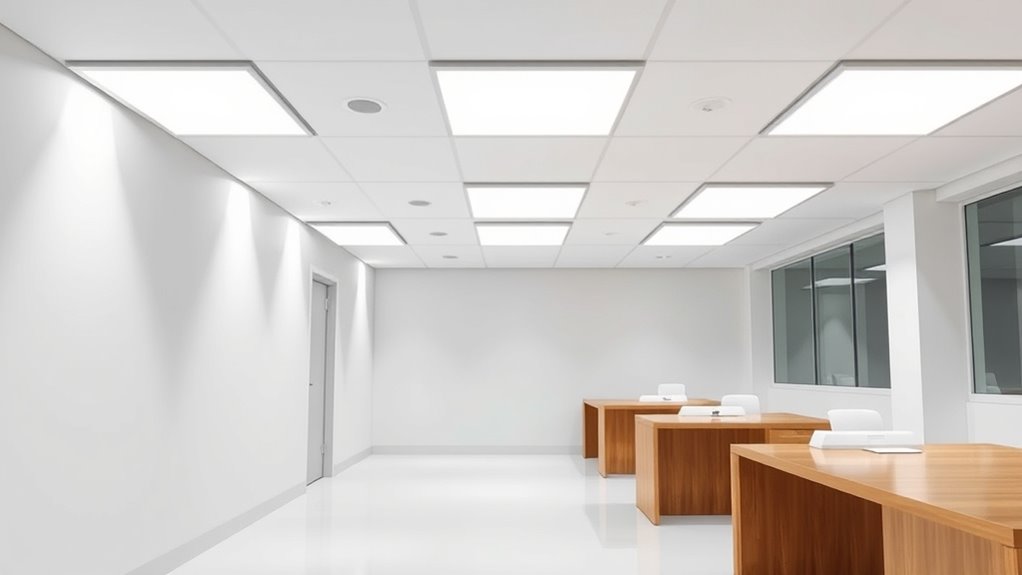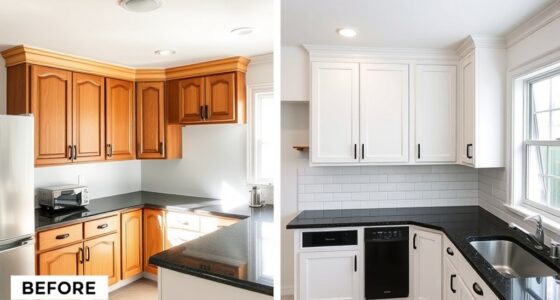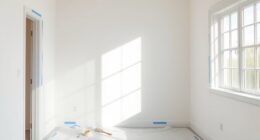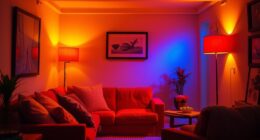Switching to LED fixtures can substantially cut your energy bills by using less power while providing brighter, higher-quality light. You’ll enjoy benefits like longer-lasting bulbs, better control options, and reduced maintenance costs. Plus, LEDs produce less heat, helping lower cooling expenses. It’s a smart upgrade that boosts efficiency and sustainability. To make the most of these benefits, there are key factors to contemplate—discover more details below to optimize your lighting upgrade.
Key Takeaways
- Conduct a cost analysis comparing initial investment, energy savings, and maintenance costs of LED fixtures.
- Evaluate current lighting needs to select suitable LED options with compatible smart features.
- Leverage rebates and incentives to offset upfront costs and improve return on investment.
- Consider the benefits of smart lighting systems for enhanced control, scheduling, and customization.
- Plan a phased upgrade focusing on high-impact areas for maximum energy savings and efficiency.
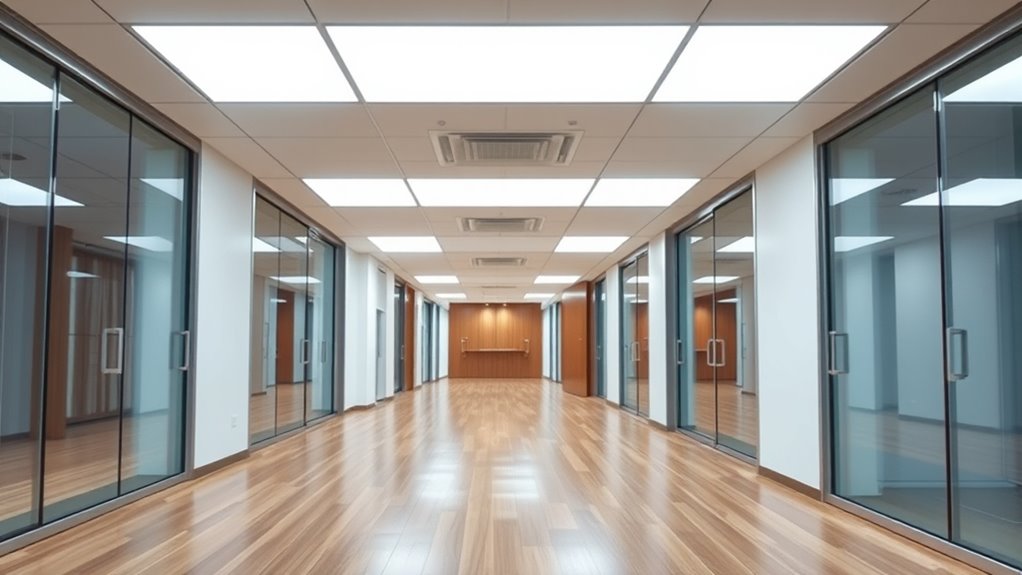
Upgrading to energy-efficient lighting is one of the simplest ways to reduce your energy consumption and lower utility costs. When you consider switching to LED fixtures, you’re making a smart choice that pays off over time. LED lighting, especially when integrated with smart lighting systems, offers enhanced control and efficiency, allowing you to tailor lighting to your specific needs. With smart lighting, you can adjust brightness, set schedules, or even control lights remotely, which helps prevent unnecessary energy use. This not only saves you money but also extends the lifespan of your bulbs, reducing replacement costs.
Before jumping into a switch, conducting a thorough cost analysis is essential. You want to compare the upfront investment of new LED fixtures and smart lighting components against your long-term savings. While LED bulbs may cost more initially than traditional incandescent or fluorescent bulbs, they consume substantially less power, which translates into lower electricity bills. When performing a cost analysis, factor in energy savings, bulb longevity, maintenance costs, and potential rebates or incentives offered for energy-efficient upgrades. This comprehensive view helps you see the real financial benefits and guarantees your investment makes sense.
Switching to LED fixtures doesn’t just save energy—it also offers superior quality and versatility. LEDs provide better light quality, with options for various color temperatures and brightness levels to suit any space. Paired with smart lighting technology, you gain even more control and customization, making your environment more comfortable and efficient. Additionally, LEDs are more durable, resistant to breakage, and generate less heat, which can further reduce cooling costs in climate-controlled spaces. Incorporating sound science principles into lighting design can even enhance the overall ambiance and well-being of a space.
The transition to LED fixtures can be straightforward if you plan carefully. Start by evaluating your current lighting setup and identifying areas where energy savings will be most impactful. Calculate the potential savings from switching, considering your usage patterns and electricity rates. When installing new fixtures, choose high-quality LEDs that fit your existing fixtures or opt for smart-compatible models to maximize benefits. Keep in mind that many utility companies and government programs offer rebates or incentives for upgrading to energy-efficient lighting, which can offset your initial costs.
Frequently Asked Questions
How Long Do LED Fixtures Typically Last Before Needing Replacement?
LED fixtures typically last between 25,000 to 50,000 hours, giving you a long lifetime expectancy before needing replacement. You’ll find that their maintenance frequency is much lower compared to traditional lighting. This means you won’t have to replace them often, saving you time and money. With proper use, LEDs can serve you reliably for years, making them a smart, cost-effective lighting choice for your space.
Are LED Lights Suitable for Outdoor or Wet Environments?
Are LED lights suitable for outdoor or wet environments? Absolutely, they are, thanks to their weather resistance and durability. You should consider installation considerations like proper sealing and choosing fixtures rated for wet locations. Aren’t long-lasting, weatherproof lighting solutions what you need for outdoor areas? LEDs are perfect because they withstand moisture, temperature changes, and harsh conditions, making them reliable and energy-efficient choices for your outdoor or wet environment lighting needs.
Can Existing Fixtures Be Easily Retrofitted With LED Bulbs?
You can often retrofit your existing fixtures with LED bulbs, but it depends on fixture compatibility and the retrofit process. Check if your fixtures are designed for LED bulbs, especially regarding size, socket type, and voltage. The retrofit process is usually straightforward—you simply replace the old bulbs with compatible LED options. However, some fixtures may require modifications or professional assistance for a safe, effective upgrade.
What Are the Initial Costs Versus Long-Term Savings of LED Upgrades?
You’ll find that the cost comparison favors LED upgrades over time, despite higher initial expenses. LEDs typically cost more upfront but save you money through lower energy bills and reduced maintenance costs. Over the long term, these savings accumulate considerably, making LEDs a smart investment. Plus, their durability means fewer replacements, so you spend less on upkeep and enjoy consistent, efficient lighting that benefits your budget.
Do LED Lights Emit the Same Quality of Light as Traditional Bulbs?
You’ll be amazed at how LED lights outshine traditional bulbs, offering stunning color rendering and flawless light distribution. They emit a vibrant, natural glow that makes everything look sharper and more colorful. Unlike dull, uneven traditional lighting, LEDs deliver consistent, high-quality light that transforms your space. So yes, LED lights provide an exceptional quality of light—bright, clear, and beautifully uniform—making your environment feel just right.
Conclusion
Switching to LED fixtures can considerably cut your energy use—by up to 75% according to recent studies. Not only do LEDs last 25 times longer than traditional bulbs, but they also reduce your carbon footprint and energy bills. Making this switch isn’t just smart for your wallet; it’s a step toward a greener future. Embrace LED upgrades today and enjoy brighter, more efficient lighting while helping the environment.
